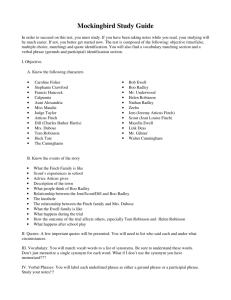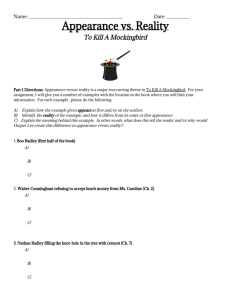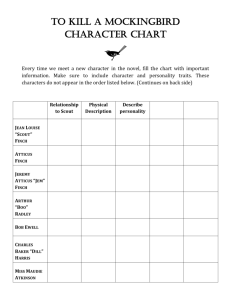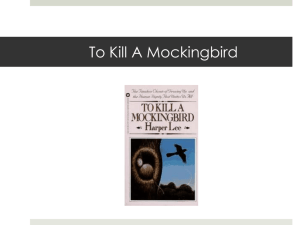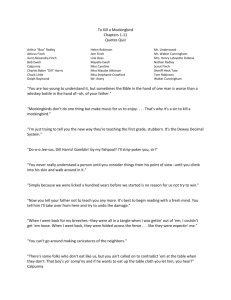To Kill A Mockingbird
advertisement
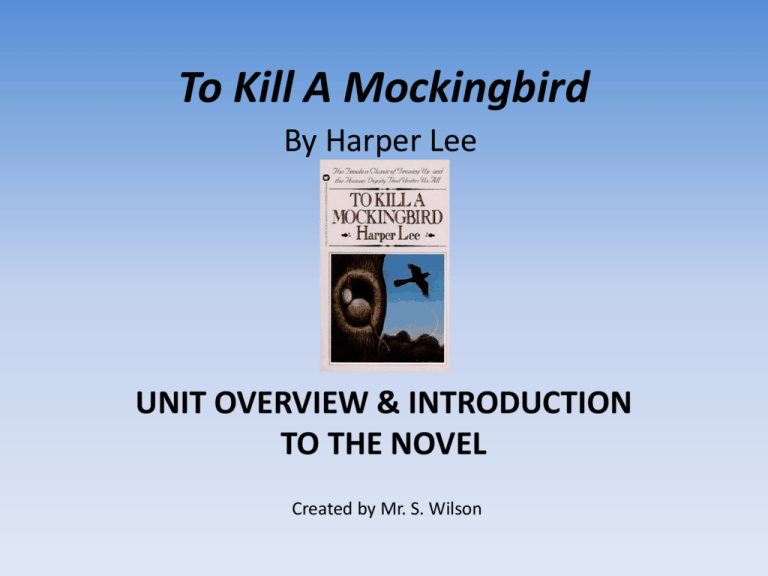
To Kill A Mockingbird By Harper Lee UNIT OVERVIEW & INTRODUCTION TO THE NOVEL Created by Mr. S. Wilson Contents of Presentation Goals of Unit • Understanding plot, setting and character development • Understanding the development of important themes • Increasing the use of vocabulary and language • Develop ability to think critically about what is in a novel or other text • Learning history of segregation, southern U.S.A., great depression and legal battles Introduction to Novel • The Characters • Plot Sequence • Themes & Symbols • Background Issues • About Author Things to Consider While Reading • Important Quotes • Using Resources Goals of Unit There are several topics that we will be focusing on during our study of To Kill A Mockingbird. These topics will help you develop important skills that you will require in all subjects throughout high school, university and your career. This unit will focus on… Goals of Unit Plot, Setting & Character Development What is PLOT? What is SETTING? What is CHARACTER DEVELOPMENT? The main events that make up the beginning, middle and end of a story. Understand WHAT HAPPENS in a story is crucial to figuring out WHY things happen. Essentially the setting is WHERE and WHEN the story takes place. To Kill A Mockingbird uses the setting of southern Alabama, the town of Maycomb and the courtroom to develop the story As the characters develop we see changes that are reflections of the plot. As things happen they learn things and move on, hopefully keeping the reader’s interest in the process. Goals of Unit Theme, Vocabulary, Critical Thinking and History What is THEME? Improve VOCABULARY! Think CRITICALLY! Learn HISTORY! Theme refers to the main idea and the purpose of the work. What is the novel trying to accomplish and/or teach the reader? To Kill A Mockingbird makes use of many words that you may not know. If you do not know the word you will not be able to understand the plot, setting, characters or theme. Therefore, this unit will focus on regular vocabulary improvement. You will learn how to question why authors make decisions about the words they use, the decisions of the characters and the events of the plot and how these things tell the reader an important message. This novel makes mention of many historical aspects that require some knowledge in order for the novel to make complete sense. Therefore we will discuss some of the history within the novel before and during our study of To Kill A Mockingbird. Introduction to the Novel To help your understanding of the novel you will be first introduced to: Plot Events Characters Themes & Symbols Background Information The Author Background Information Introduction to the Novel The Main Characters Atticus Finch Jean-Louise “Scout” Finch Charles “Dill” Harris Arthur “Boo" Radley •Lawyer and prominent citizen •Family has been in Maycomb for generations •Father of “Scout” and Jem •Defends Tom Robinson •Strong morals •Female narrator of story •Often tells of her past, (so setting and timeline jumps a great deal) •Daughter of Atticus •Explores theme of “judgment” based on relationship with Boo Radley •Boy who visits Maycomb each summer •Seven Years old •Befriends “Scout” and Jem •Very smart; enjoys reading and acting out stories •Thirty-three year old recluse next door •As a child committed a crime and was kept home by his father •Does not leave house later in his life except at night •Rescues children and befriends “Scout” Bob Ewell Tom Robinson •Daughter accuses Tom Robinson of rape •Feels ashamed that a white man made accusations about his family •Terrorizes Finch family •Killed towards end of story •Young black man accused of raping white girl •When in court, clear evidence defending him is ignored due to discrimination at time •Sentenced to death •Shot dead during escape attempt Introduction to the Novel Plot Sequence The “Boo Radley” Plot Introduction to the characters including the Finch family history, “Scout” and Jem, “Dill” Harris and the interesting history of Arthur “Boo” Radley Development of the children’s antics in their pursuit of “Boo” Radley, which includes dares and games to get his attention. During this part Atticus Finch warns the children to not judge “Boo” – they need to live life in his shoes. Children trespass on Radley property and are shot at, causing Jem to lose his pants. This further develops “Boo’s” character as we witness his actions. Introduction to the Novel Plot Sequence The “Tom Robinson” Plot A white woman, Mayella Ewell, is raped. She accuses Tom Robinson, a black man. Atticus Finch agrees to defend Robinson, which angers and upsets Maycomb. Maycomb is furious about trial and collectively wants to lynch Robinson. Finch faces uphill battle based on black’s position in society. Trial becomes one-sided despite clear evidence in favour of Robinson. Robinson was in relationship with Ewell according to factual evidence but nonetheless, Robinson found guilt and sentenced to death. Robinson, clearly innocent, tries to escape the jail and is shot to death Ewell family attacks the Finch family due to the “shame and humilation” Atticus Finch subjected them to during the trial.. Introduction to the Novel Plot Sequence Connecting the Two Plots Over the course of the novel, Dill, “Scout” and Jem continue to build a relationship with “Boo” Radley, trying to get him to come out of the house during the day After the trial of Tom Robinson, the actions of Bob Ewell, (father of “victim” Mayella Ewell, progress from menacing the Finch family to breaking into the judge’s house until he finally attacks Jem and “Scout”. “Boo” Radley save Jem and “Scout” and Bob Ewell dies. “Boo” is then forced to return to hiding in the Radley house “Scout” finally understands what her father said about not judging a person and this reinforces her belief in the ultimate goodness of man. Introduction to the Novel Exploring Themes Good vs. Evil Morals: Right and Wrong Social Inequality, Racism and Discrimination • Moral reasoning by Atticus Finch • Acts of “Boo” Radley • Loss of innocence • Acts of the Ewell family: deception, harassment, lies and violence • Perspective: Life in someone else’s shoes • Atticus Finch defending Tom Robinson • “Boo” Radley and his background • The treatment of Tom Robinson • Racial divide between blacks and whites during time period • Treatment of whites who defend blacks Introduction to the Novel Exploring Symbols …Be on the lookout for: SYMBOL: A word or object that represents another word or object Small-Town Life “Boo” Radley Mockingbirds / Birds What do these symbols represent!? Introduction to the Novel Background Information To Kill A Mockingbird includes several references to historical events. Knowing some information about this events is important for understanding the novel. Introduction to the Novel Background Information 25% of population had no job Hundreds of thousands lost homes, farms and possessions Even those with jobs were affected because nothing was being produced GREAT DEPRESSION A period of extreme drought, poverty and hardships during the 1930s. Average family income dropped to 50% by 1935 Stock Market Crash caused people to lose billions. Entire banks were wiped out and by 1933 over 60% of population was considered poor The novel takes place during the mid-1930s at a time when the government was attempting to stop the Great Depression. The President at the time, Franklin Roosevelt, famously said, “the only thing to fear is fear itself” as his government created programs to create jobs, house the homeless and feed the starving. Introduction to the Novel Background Information Racism and Social Classes Although slavery was abolished in the 1890s racism and discrimination were alive and well during the time of the novel. The novel is based on many historical facts that help to drive the story, (and allow the readers to explore a sad time in American history) including: Jim Crow Laws (1890s – 1960s) Scottsboro Trials (1931) Social Inequality (Forever) Introduction to the Novel Background Information The Finches Social Inequality White folks of Maycomb & Maycomb County The Ewell Family Tom Robinson Even the law was one-sided: Juries were always all-white and all-male. The word of a black man meant nothing against the word of a white man. Introduction to the Novel About the Author To Kill A Mockingbird is semi-autobiographical for a number of reasons: Lee grew up in Alabama Father was prominent lawyer Experienced Great Depression, Scottsboro Trials “Scout” based on her life; “Dill” based on life of childhood friend Truman Capote Things to Consider While Reading The first time you read the novel should be to get a general idea of the setting, characters, plot and themes. However, because this novel can be difficult you are provided with some things to think about while reading that will help you understand the novel. Things to Consider While Reading Important Quotes As you read be on the lookout for these important quotes from the novel: “Why reasonable people go stark raving mad when anything involving a Negro comes up, is something I don't pretend to understand… I just hope that Jem and Scout come to me for their answers instead of listening to the town. I hope they trust me enough…” -Atticus Finch Things to Consider While Reading Using Resources Having difficulty understanding the novel? Try these resources: Sparknotes – Free Web Resource: http://www.sparknotes.com/lit/mocking/ TKM Student Survival Guide Wikipedia.org: To Kill A Mockingbird Don’t forget about me! Ask me questions you may have! To Kill A Mockingbird By Harper Lee Presentation created by Mr. S. Wilson Geraldton Composite High School – Geraldton, Ontario
